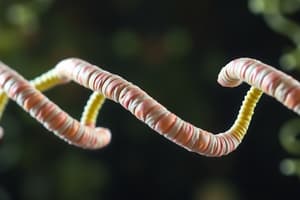Podcast
Questions and Answers
Most proteins are metabolized in ______________
Most proteins are metabolized in ______________
the liver
Basic unit ______________ linked together by ______________ to make proteins
Basic unit ______________ linked together by ______________ to make proteins
amino acids, peptide bonds
Protein breakdown in the body produces ____________ and ____________
Protein breakdown in the body produces ____________ and ____________
amino acids, urea
Urea produced in ___________ and eliminated in _____________
Urea produced in ___________ and eliminated in _____________
What does the word protein come from?
What does the word protein come from?
Who named the protein?
Who named the protein?
What was the first protein to be sequenced?
What was the first protein to be sequenced?
What are the two main processes of protein synthesis?
What are the two main processes of protein synthesis?
What assists polypeptides in folding into functional proteins?
What assists polypeptides in folding into functional proteins?
Which of the following are classes of proteins?
Which of the following are classes of proteins?
Proteins are rigid molecules.
Proteins are rigid molecules.
What common experimental methods are used for structure determination of proteins?
What common experimental methods are used for structure determination of proteins?
What is the most abundant circulating plasma protein?
What is the most abundant circulating plasma protein?
Which of the following can cause variations in plasma protein concentrations?
Which of the following can cause variations in plasma protein concentrations?
Hypoproteinaemia refers to an increase in total protein levels.
Hypoproteinaemia refers to an increase in total protein levels.
Increase in total protein (_________________) may be due to:
Increase in total protein (_________________) may be due to:
Decrease in total protein (hypoproteinaemia) may due to:
Decrease in total protein (hypoproteinaemia) may due to:
Flashcards are hidden until you start studying
Study Notes
Protein Metabolism
- Proteins are broken down into amino acids and urea.
- Urea is produced in the liver and eliminated in urine.
Protein Structure
- Proteins are folded into unique three-dimensional structures.
- Globular proteins are soluble and include albumin, globulins, protamines, and histones.
- Fibrous proteins are structural and include keratins and collagen.
- Membrane proteins act as receptors.
Protein Determination
- X-ray crystallization and NMR spectroscopy can be used for structure determination.
- Electrophoresis is a common method for analyzing plasma proteins, separating proteins into five bands: albumin, alpha1 globulin, alpha2 globulin, beta globulin, and gamma globulin.
- Total protein can be measured using the biuret reagent.
Serum Protein Electrophoresis
- Serum proteins are separated into six groups: albumin, α1-globulins, α2-globulins, β1-globulins, β2-globulins, and γ-globulins.
- Albumin is the most abundant circulating plasma protein, responsible for maintaining colloid osmotic pressure and transporting various ions, acids, and hormones.
Plasma Proteins
- Variations in plasma protein concentrations can be due to changes in the rate of protein synthesis, the rate of removal, or the volume of distribution.
- Protein disorders can be caused by genetic mutations, environmental toxins, aging, or malnutrition.
Total Protein
- Increased total protein can result from haemoconcentration (dehydration), poor kidney function, acute and chronic infections, acute liver disease, and multiple myeloma.
- Decreased total protein can result from decreased protein formation (liver disease), insufficient protein intake, or severe hemorrhage.
Studying That Suits You
Use AI to generate personalized quizzes and flashcards to suit your learning preferences.



